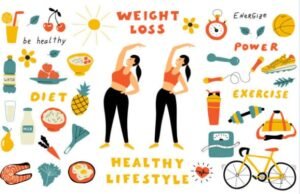
by admin | Jan 7, 2022 | Mind
Mood Swings | Part 2 – Managing Your Emotions
Gaining Control Over The Automatic
In part one of this article series, you learned more about mood swings, their nature, and main causes.
With all that information in mind, you are now one step closer to resolving any emotional issues you may hold deep within.
Why you may ask?
- Well, because to resolve a certain problem completely, you don’t need ‘just a solution’.
- You need an understanding of the core of this problem and why it arose in the first place.
- As a matter of fact, this deep understanding can also lead to logical conclusions that highlight the exact path towards the resolution of the problem at hand.
- Nevertheless, having concrete cues as to the methods you can use to manage mood swings and your emotional states, as a whole, can also massively help!
- In this second part of the article series, we’ll cover just that.
And so, are you ready? Let’s start!
Maintaining A Steady Mind

If you’ve read some previous materials on our blog, you have probably seen us mention that the modern-day lifestyle and social dynamics can easily kick your mind off-balance.
In a world like this, it is crucial to establish the skills necessary to keep your mind steady, in order for you to be able to guide it to whatever path you are looking to take.
Based on experience, we would say that this has 3 main aspects:
- Stress management
- Lifestyle choices
- Different perspectives
Let’s start with the most important one – Stress management!
Stress Management

- Alright, if the most common culprit for mood swings is stress, then it makes sense for the easiest fix to be stress management.
- Depending on the kind of stress you are experiencing, you may need different types of solutions.
- For instance, if you are under extreme momentary discomfort, you can try different breathing techniques.
- However, yoga may be a better idea if you are dealing with stress that has accumulated through time.
- Whether you find it peaceful to be alone or with people, managing stress is absolutely possible and will ease the shifts in your mood.
- And yes, yoga and other exercises can help, but stress management is done on a level of perception at the deepest level.
- So, whenever you experience a stressful situation, try to stay aware of your reaction to it and start questioning it.
- Because reactions involve a great level of emotional output and are automatic, we usually follow their sequence.
- But suppose you use your most powerful tool. In that case, awareness and consciousness.
- And you use that to question the automatic behaviors, well then, your emotional reactions will change over time, thus leading to less prominent mood swings.
- This is base 1. From then on, you have to get back to your natural human patterns, and your emotional transformation will be complete!
- Let’s have a look at the lifestyle choices you can abide by to resolve mood swings!
Lifestyle Choices

As we mentioned, your lifestyle choices massively impact the internal chemistry your body is running on.
Bad chemistry means poor emotions and poor emotions mean more frequent mood swings.
Think of it this way – Your body was designed to work in a certain way (that we call ‘natural’) and if you get further from that (which the modern lifestyle pushes us towards), well, you know what happens.
So let’s have a look.
You’ve Got To Move It Move It
Ah, yes, exercise.
- When you are consistently active, the machine your body is starts working in the best way it can because it has the best incentive it needs.
- Not only that but exercise also releases endorphins that are responsible for regulating stress and overall mood.
- By teaching your body to be consistent, your mind will likely follow and naturally start fighting rapid shifts in mood.
- Even just a 30-minute workout once every two days will positively affect your emotional state.
- Oh, and not to mention, you will start looking better as a side effect.
Think of it this way – The body was DESIGNED to move! Just look at your complex musculature – It’s begging for you to get up and move so that the body can fulfill its true potential.
So get up. Sprint. Climb. Jump, crawl and swim – Find a way to move that you love, and stick to it!
Wake Up, Sleepy Eyes!
Getting the amount of sleep you need with the quality you need is synonymous with feeling like the normal you.
We have all had sleepless nights or experienced difficulties when trying to do something taxing early in the morning, and we all know how that made us feel.
Sleeping well is vital for the way you perceive the world and therefore what emotion it incites in you.
This is why people that have chronic problems with sleep often have mood swings.
So try this:
- Go to bed at the same time
- Avoid eating heavy meals right before bed
- Avoid screentime in the last 1-2 hours before bed
- Create a bed routine
Eat Like Your Ancestors
- If you’re not getting all the nourishment you need, you may experience negative changes in your mood.
- This is why some people are cranky in the morning – lower blood sugar and caffeine withdrawal (if they drink coffee daily) can make a person easily irritable.
- Malnourishment works in the same way but on a deeper level – food is the body’s fuel, and you can’t expect it to work properly if it doesn’t receive what it needs.
- This is also why some digestive disorders are associated with mood swings (pssst, it’s all in the gut!)
- Certainly, though, eating well nowadays is something very hard to do, mainly because we are constantly bombarded with ultra-processed foods.
- Nevertheless, that doesn’t mean you can’t find food close to the natural quality that our hunter-gatherer ancestors had.
Here are 7 of our best-rated foods everyone should focus on:
- Grass-Fed beef
- Eggs From Pasture-Raised Chicken
- Wild-Caught Salmon & Other Seafood
- Dairy Products From Pasture-Raised Animals
- Root crops (carrots, potatoes, beetroot, etc.)
- Fruits & vegetables
- Nuts
Besides focusing on those, one should also avoid highly processed foods and if consumed, they must not represent more than 10-15% of an individual’s total daily food intake.
Just Ask Someone!
If you are worried that your mood swings are a sign of something deeper or just have trouble dealing with them easily, you should seek the advice of a therapist.
There, you will find the answers to all your questions and start working on a plan to keep your emotions in check.
Different types of therapy offer different solutions, and you will undoubtedly find one that suits your needs.
One of our top recommendations, though, is Cognitive Behavioral Therapy (CBT), because this strongly relates to one’s perception about things, and this is precisely where the change is made!
Final Thoughts
Mood swings are a common problem for many people, especially in today’s fast-paced society.
This is exactly why you can find a lot of information about them and advice on dealing with the challenges they pose.
Although sometimes such seemingly random shifts in your emotions may seem scary or make you feel powerless, it’s crucial to remember that there is nothing you won’t learn to handle with time.
Start with small changes to your daily life and see where they take you and how they make you feel, and always know that you can get help the moment you feel you want to.
Stay balanced!

by admin | Jan 7, 2022 | Mind
Mood Swings | Part 1 – Definition & Causes
Understanding The Dynamic Nature Of Your Emotions
Thanks to experiments and proven theories, we now know that the entire universe is constantly searching for balance, trying its best to avoid extremities at all costs.
Similar to the pendulum of a clock, we, like the universe, constantly search for the golden middle.
- We do this both consciously and subconsciously in pretty much every aspect of our lives – work and rest, spending time with friends and alone, working out and relaxing.
- We do most of the basic human activities with the idea of establishing a balance between them.
- This is why, when your emotions are stronger than normal, it can feel challenging to go about your day as you usually would.
- Although mood swings are common, we aren’t always sure why they happen and how to control them exactly.
- Sometimes the intensity of our current emotions doesn’t have an explanation, and we find ourselves questioning everything that surrounds us.
- This is not only exhausting but can sometimes have a more lasting negative effect on us, our relationships, and the overall quality of our lives.
- For those and many more reasons, we’ve decided to shed some light on how to understand your feelings better and take the first baby steps towards establishing control over them.
What Do Psychologists Say?

Certainly, whenever we have an acute change in the state of an individual, there will be a bunch of psychologists trying to explain it.
So here comes the question-
What Are Mood Swings, Exactly?

Psychologists identify mood swings as great and sudden changes in the current emotional state of an individual.
When you quickly go from feeling happy and upbeat to being easily irritated and blue, you are likely experiencing precisely this phenomenon known as a “mood swing.”
Sometimes mood swings are a part of an underlying condition, and sometimes they are the side effects of the many challenges we deal with that are a normal part of life.
Why Do They Happen?

The most common reason for mood swings is… You guessed it – Stress!
Regardless of whether it’s sudden and extreme or accumulated over time and seemingly negligible, stress is the most common cause for rapid changes in our emotions. When we are under pressure, we can’t focus on keeping everything in check, and we sometimes neglect our feelings, resulting in them spiraling out of control.
This is precisely why we sometimes end up experiencing random shifts in how we feel towards certain people, events, and topics. Significant life changes are also widely known to cause shifts in mood. Whether this process happens subconsciously or not, we often respond more emotionally to things when something big is currently happening in our lives.
For example, getting married, finding a new job, becoming a parent, moving to a different city – all these things have a resounding effect on our temper and perception.
This phenomenon makes sense in the world when you think about all the emotional thoughts we have while experiencing such events and all the pressure and excitement they often bring us.
Moodswings As A Symptom
One of the lesser-known things is that mood swings are also a part of almost all mental illnesses – depression, bipolar, and borderline personality disorders are just to name a few in which rapid changes of mood are extremely common.
This information should be considered by the patient and the doctor treating these conditions because it may change the final way of dealing with the problem.
Mood swings can also accompany Alzheimer’s, strokes, and other conditions that affect the brain.
Hormone changes are also a common cause of mood swings.
For women, the hormone estrogen often has this effect which is dispensed during the menstrual cycle and pregnancy, and for men, that can usually be caused by testosterone and other major hormones that also undergo a cycle.
Regardless of whether you are undergoing hormone treatment or just the body’s natural response to something, a hormonal imbalance in your body can often make you feel emotions more intensely.
Medication As A Cause
A different reason for experiencing these fluctuations is if you are using certain medications or are in the process of changing your prescription.
For example, mental health medicine often has this side effect, especially if you take it for the first time or change your usual routine.
This is because it is designed to work with the part of your brain which deals with emotions, and there is a period of adaptation in which the brain gets used to the change.
However, other types of medications can be a reason for mood swings, and you should ask your physician if you are experiencing this and believe it’s because of your prescription.
How Common Are Mood Swings?
- Most people experience mood swings at least a few times a year.
- This is completely natural because they are often subconscious responses to things that happen to us, some of which are beyond our control.
- We are incredibly emotional beings, and as such it’s impossible to expect this part of us will always be under our absolute control.
- As a matter of fact, trying to keep everything under strict management is often why we end up having mood swings in the first place.
- With that being said, if you are experiencing them a lot more often and they hinder your life in any way, you should ask for the advice of a professional as it may be a symptom of an underlying condition.
- Nevertheless, before doing that, you can also consider having a read over our second article of this series, where we go in-depth on the steps you can take towards successful emotional management.
Swing by to part two by clicking HERE

by admin | Jan 7, 2022 | Fitness, Health
Lifestyle Optimization Pt 2 – Making The Right Food Choices
In part one of this article series, we learned that our modern-day ways of living had robbed us of movement, thus bringing the global fitness levels to an all-time low.
Well, luckily, more and more people are becoming aware of this, and with the help of fitness training, the trend is slowly beginning to change.
Besides the deprivation of movement, however, we’ve also seen a drastic shift in our eating habits.
Both combined have led to abnormal changes in body composition across all ages and demographics.
Now, in this second part of the article series, we’ll shed some light on food choices and how you can make the best such for the goal of optimizing your overall quality of life.
Ready to learn? Let’s dive!
Food Habits, Currently

- If you have an objective look at how modern-day eating habits go, you’ll see a pattern – We’re constantly being bombarded with highly-processed, delicious, well-marketed foods.
- Even more so, the convenience of our world has allowed us to get these exact food products delivered to us, without the need to do something more than stand up from the chair to greet the delivery guy and take the order.
- This junk food bonanza has totally shifted the human species from the natural ways of feeding & nourishing the body nutritionally.
- Now, granted, we won’t preach any “diets” here – All we’re vouching for is for everyone to pay attention to what we like to refer to as “nutritional culture.”
- Think of “culture” as all the ways of life of a population that are passed down from generation to generation, including the most crucial one – Eating!
Evolutionary-Appropriate Eating

- Besides the proper nutritional culture that states “eating is a form of self-care that needs a reasonable, balanced approach,” there is another thing we like to refer to as “evolutionary-appropriate eating.”
- This term may sound fancy but think about it – Given the complexity of the human body, we can say that this exact organism has gone through a LOT during its evolution.
- And one of the things that shaped it as it is, is namely the way of eating.
- And trust us when we tell you this – The body has existed for perhaps hundreds and thousands of years, and it’s only been exposed to such an abundance of unnaturally processed foods for a couple of decades!
- So, you see, there is certainly a correlation (and perhaps causation) between the recent rise of packaged & processed foods and the epidemic of diseases.
- Now you may be wondering – What is it that one can do to counter this?
- And the answer is… Eat evolutionary-appropriate foods!
- Consume the WHOLE foods that our ancestors hunted for and grew.
- Choose local rather than mass production.
If a food product is mass-produced and has a marketing department behind it, avoid it because it is likely to heavy a ton of additives that you don’t really want in your body!
Choose These Foods!

Alright, let us be a bit more specific here and give you our list of food products to place at the core of your nutritional habits.
- Grass-fed & Grass-finished Beef (meat/organs)
- Pastured pork/chicken
- Eggs from pastured chicken/poultry
- Dairy from grass-fed cows
- Root crops (potatoes/sweet potatoes/beetroots/carrots)
- Fruits & veggies (avoid mass-production, focus on local!)
- Olive oil (avoid using for cooking)
- Bee honey
- Wild-caught fish
- Wild-caught seafood
Combining all of these foods and bringing balance across your macronutrient profile will provide you with all the energy for your daily physical activities, as well as everything needed to maintain the healthy functioning of all your bodily systems.
Now, this doesn’t necessarily mean you should totally exclude your favorite ice cream or junk food – Just bring the balance in favor of the nutrient-dense, high-quality food products!
Final Thoughts
The key to understanding evolutionary appropriate nutrition is recognizing the importance of consuming foods that are natural, healthy, and nutrient-dense.
With a little bit of knowledge about how unnatural modern-day mass-produced nutrition is, you’ll be able to find your own path towards making better food choices that can positively impact your physical and mental well-being.
So here’s for a wrap on this article series – Move as your ancestors did. Run, jump, climb, crawl, dive and swim. Lift some weights even!
And focus on whole, minimally processed locally grown foods!
Optimize your lifestyle. Stay healthy.

by admin | Jan 7, 2022 | Fitness, Health
Lifestyle Optimization Pt 1 – Becoming More Active
If you’ve been feeling off mentally, physically, and emotionally as of late, the odds are that one or more things in your lifestyle need some proper optimizing.
And well, the truth is that most people feel that way nowadays, whether it is chronic or just from time to time.
This is without a doubt because the cities we live in make life relatively easy – We tend to live sedentary lives, and while doing so, we can easily get junk food delivered to our doorstep.
It almost seems like the cities were designed to deprive us of our natural ways of moving and eating.
With this in mind, we’ve decided to share our take on this in a 2-part article series, with the goal of helping you optimize your lifestyle, which will, in turn, lead to a better quality of life overall.
In this first part, we’ll get through one of the most important aspects of lifestyle optimization – Becoming more active!
But first, let’s answer an uncommon yet important question.
Is Fitness An Achievement?

Many people nowadays consider that becoming active and having good habits as a whole is somewhat an achievement.
But with the above-said in mind, we concluded that the modern-day lifestyle has taken us away from our natural movement & eating patterns.
Therefore… If or when you start moving more, eating & sleeping well and improving your levels of fitness… Is that an achievement, or just something you get back to?
Well, that’s certainly some food for thought, but for now, let’s have a look at the different types of training one can do to get back to the natural fitness that we’re all supposed to have and enjoy.
Types Of Training

If you know a thing or two about the human body or have heard about certain sports achievements of fellow human beings, you know for a fact that the body is capable of a LOT.
- This is perhaps due to the myriad of environments the human body has been through and had to adapt and thrive in.
- And well, whatever the case may be, facts are facts – We have access to an incredibly capable configuration of muscles and bones.
- Now, generally speaking, most types of training/exercise fall into two main categories – Aerobic & Anaerobic.
- Both of these utilize different components in the body and lead to different adaptations (end results of the training stimulus).
- So let’s analyze each type of training so you can determine which one fits your goals better.
Anaerobic Training
- First and foremost, we have the most common type of exercise – Anaerobic training.
- The term “anaerobic” is derived from the 3 Greek words – An, aeros & bios, meaning “no,” “air,” and “life,” respectively.
- In simple words, anaerobic training activities do not require oxygen to use up the energy needed to execute the movement.
- Generally speaking, anaerobic training activities are of high intensity and short in duration.
- Think weightlifting, sprints, HIIT training, etc.
- This type of training engages the fast-twitch muscle fibers, responsible for power output, maximum strength and… Visual muscular development!
In terms of hormonal stimulus, visual changes to the body & the development of strength, explosiveness, and strength endurance, this is the type of training you’d want to opt for.
Aerobic Training
- On the other hand, we have Aerobic exercise, also referred to as “cardio training.”
- This is opposite to anaerobic and thus, requires oxygen for the energy to be used during activity.
- Aerobic training activities are of low intensity, but as compared to anaerobic exercises, they are way longer in duration.
- Think of aerobic training as any activity that isn’t strenuous but is long in duration.
Aerobic training activities include but are not limited to:

- Jogging
- Running
- Rope skipping
- Swimming
- Cycling
Aerobic training activities don’t really have a prominent effect on visual & strength development, but they can help you increase long-distance endurance by optimizing the work of your heart & lungs.
Which Type Should I Choose?
- To further clarify what we’ve said so far, think of the two types of training as… Two types of training with different results!
- Ultimately, there isn’t really a “better” type of training if it’s not put into context.
- What we mean here is that both types of training have their advantages, simply because they produce different end results!
- Both have health benefits.
- Both help you develop certain physical properties.
- Both allow you to enjoy the freedom of movement.
Ultimately, your best bet is to do both on a regular basis, with an emphasis on the one that resonates more with your goals.
Do you want to be stronger, more explosive, and improve your body visually? Go for anaerobic training and do some cardio (aerobic training) here and there.
Do you not care about looks and strength as much but want to be a beast over long distances? Go for aerobic training and do some weights here and there.
Try This!
If you’re someone who just wants to get off of their butt and get a little from everything that the body is capable of, try this simple workout routine 2 to 3 times a week, with at least two days of rest between each session.
NOTE: “Close to failure” means that the set should be challenging and get you close to the point where you can’t complete another rep unassisted.
| Exercise |
Sets |
Reps/duration |
Rest times between sets |
| Rope skipping |
1 |
4-5 mins |
|
| Squats (Either bodyweight, barbell or machine) |
5 |
6+ close to failure |
2.5 to 3 minutes |
| Horizontal or incline bench press (either with barbell or dumbbells) |
5 |
6+ close to failure |
2.5 to 3 minutes |
| Deadlift (Either with a barbell or dumbbells) |
5 |
5, close to failure |
3 minutes |
| Rope skipping/other cardio activity |
1 |
20 mins |
|
This full-body circuit will give you the best of both worlds – Plenty of stimulus for strength, explosiveness and visual development, but also a great deal of cardio endurance!
Sooner or later, you’ll be addicted to seeing improvements in how you look, perform and feel!
And trust us – When this happens, you’ll be HOOKED and will look for ways to further improve this.
When that happens, reach out to us at _______
And until then, remember that movement is just one part of lifestyle optimization.
The other, even more important part is to make the right food choices.
We have that covered, too, so follow up with us over on the 2nd part of this article series by clicking HERE!
See you there!

by admin | Jan 7, 2022 | Mind
Learning To Take Your Own Feelings Into Account
The Effects Of Social Media And How To Hear Your Own Voice In A Sea Of Others
There’s a lot to be said about human emotion because, quite frankly, it is very complicated.
Many scientists believe that some of the fundamental differences we as a species have are because we feel certain emotions in specific ways.
The way we understand and experience love, anger, care, disappointment, or hope is crucial in formulating how we act in many situations and can change our futures in the blink of an eye.
This is why genuinely understanding our emotions is so important – by figuring out how different situations make us feel and where the roots of those feelings lie, we can understand how they govern us and potentially what we would like to change.
Social Media And Society’s Opinion

We live in a time where feelings are simultaneously being broadcasted and hidden which may sound like a paradox but is, in fact, very true!
Let’s focus on social media – the center of attention for a big part of modern society.
At its core, this is a virtual space explicitly made so that people can share exactly how they feel in each moment.
Videos, photos, posts, tweets, comments, reactions – all of these are essentially forms of self-expression that allow us to convey our innermost desires, fears, opinions, and hopes.
A digital, eternal library of our human experience where everything is said, shared and stored.
This has its obvious positive sides – freedom of speech for one, is actively supported, which hasn’t always been the case.
Creativity is encouraged and given its due credit, thus broadening all sorts of cultural knowledge and allowing all kinds of talents to be noticed and appreciated despite where they come from and what they are.
Forming an opinion and standing by it has also never been easier, which is tremendously beneficial because it focuses the individual’s attention on their personal choices and the reasons behind them.
These things are all connected with emotions and have all had an impact due to the exponential growth of social media.
The Paradox

Now, this is where the paradox mentioned above comes into play.
For one, by having all of this information just a few clicks away, it’s easy to feel overwhelmed or even discouraged to share your thoughts and ideas – after all, there’s always going to be someone better than you.
Historically speaking, there hasn’t been a time in which the previous statement was not true.
However, today we can find and keep our focus on each person who is superior in our eyes.
Sure the people who lived before the golden age of the internet also understood that they probably weren’t the absolute best in their respective fields, but it’s a different thing to realize this in theory and actually to see those people and their achievements every day.
This often takes a toll on our self-esteem and makes us disregard our feelings and thoughts.
The Aspects Of Social Media

With the above-said in mind, we would like to make another important mention here – just because you see it, doesn’t mean it’s the whole story!
Social media posts tend to be highly positive – unrealistically so.
It’s natural for the creator only to want to share their finished product or their final thoughts, without mentioning all the hardship that came before that.
However, the viewer often forgets that this hardship was the central part of the narrative.
By seeing everyone else’s lives through rose-colored glasses (or filters), we often end up judging ourselves because our worlds have different nuances and colors.
This can bring us to the conclusion that we shouldn’t take our own emotions or even ourselves as a whole into account, which is precisely why social media is a double-edged sword.
In a sense, social media is a highlight of people’s lives – Not the entire story.
Listening To Your Own Feelings
So how do we battle this? Social media is far from the only perpetrator of lowering self-esteem, but it is also a great example of one because most of us use it daily.
Regardless of if you’re talking about a bully you had in your class or some stranger’s opinion on the internet, you probably can’t do much to change the negativity that is being thrown your way, and you shouldn’t have to.
Negativity will always be a part of our lives the same way positivity will always fight it back.
Instead of changing the outside factors (a task which can not only be exhausting but is sometimes plain impossible), what you can do is focus on what’s under your control – your own perception.
By listening and understanding your emotions, you become the master of how those negative people or things affect you.
An excellent first step is to ask yourself questions – as much as you can and as often as possible.
Get to know yourself more, understand why you like what you like, how different things make you feel when you are happy, what makes you sad, what you want to hear when you’re in a bad place, your hopes, and dreams, etc.
For instance, the questions you can ask someone you want to be friends with are almost identical to the ones you can ask yourself and you should focus on your answers just as much as you would if it were a different person giving them.
What this process of asking and answering your questions does, is it switches your focus from the outside world to your inner reality.
With this shift, you start understanding why your feelings and thoughts have just as much value as everyone else’s and why your opinion is just as important.
After that, it’s much easier for you to share the emotions and ideas you have with the world.
You see, when you truly understand something – its origins, its current form, and its future effects, you are more confident when you are facing it as well as when you have to explain it to someone else.
The same way you find explaining simple things to kids easier than untangling complicated theories when you have all the answers using straightforward language, it’s much more comprehensible both for you and for your audience.
In addition, this newfound conviction that comes with knowledge allows you to be more open and truthful and therefore attract the proper response.
From that point on, everything is pretty much smooth sailing.
Take-Home Message
This first step to learning to take your own feelings into account is hard and takes some getting used to.
Nevertheless, it is vital in bettering our opinion of ourselves and the importance we give it.
By learning to take your emotions into account, you will undoubtedly find out new things about yourself, how to pay attention to them, and why you couldn’t see them before.
This form of self-realization and the change that comes with it is something that everyone should experience because it brings you closer to the person you ultimately want to be – a person who truly understands themselves and is happier for it.


























